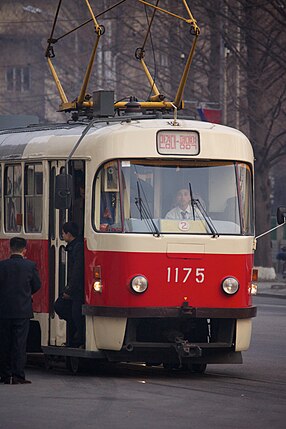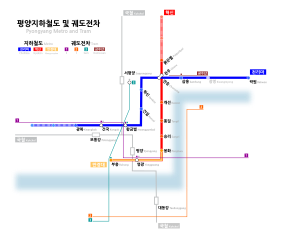Pyongyang tram
| Pyongyang tram | |
|---|---|
| Basic information | |
| Country | North Korea |
| city | Pyongyang |
| opening | April 15, 1991 |
| electrification | April 15, 1991 |
| operator | Transport and Communication Commission |
| Infrastructure | |
| Route length | 53.5 km |
| Gauge | 1435 mm, 1000 mm |
| Operating mode | Bidirectional operation |
| Tunnel stations | 0 |
| Depots | 3 |
| business | |
| Lines | 4th |
| Cruising speed | 50 km / h |
| vehicles | Be 4/4 , Tatra T3 , Tatra T4 , Tatra T6B5 , Tatra KT8D5 |
The Pyongyang Tram is an electric tram in Pyongyang , the capital of North Korea .
Trams are part of the local public transport network and open up those parts of the city that cannot be reached by metro or the local trolleybus . Public transport plays a key role because there are hardly any private cars in North Korea .
history
The beginnings of the Pyongyang tram network go back to the time when Korea was a colony of Japan . The company was founded in September 1905 and built a double-track line from the train station to the city. The 24 cars for four people each were pushed by people ( Kuli-Bahn ). The number of passengers was around 90,000 in 1911, around 80,000 in 1912 and around 75,000 in 1913. In 1914 there was a two-kilometer route with a track of 610 mm.
In 1922, the first electric tram was put into operation instead of the hand-operated tram previously used . The first double-track line, starting from the station, was built between April and July 12, 1922. Another expansion took place in 1925 and 1927.
After the Korean War , the tram service was given up due to severe damage. Since North Korea has to import crude oil and the fuels were assigned preferentially to the military, Pyongyang relied on the electrically powered subway and trolleybus. When the capacity of the trolleybuses was no longer sufficient, the city administration decided to build a tram network again.
The grand opening of the first new tram line (Songsin – Man'gyŏngdae) took place on April 15, 1991, the 79th birthday of Kim Il-sung . It was opened to the general public three days later. In 1992 a second line (T'osŏng – Rangrang – Munsu) was added. These two are standard gauge .
The third line ( Kŭmsusan Line , Sŏp'yŏngyang – Rangrang) went into operation in 1996. Their gauge is 1000 mm (3 ft 3 3/8 in) as opposed to others that are 4 ft 8½ in (1,435 mm). It is primarily intended for tourists and connects Samhung Subway Station with the mausoleum of Kim Il-sung . The cars for this free connection were made in Switzerland.
At the end of the 1990s there was a power cut due to a lack of fuel and the desperate state of the electricity supply, which also affected the tram. This situation has improved in recent years.
In 2003, the P'yŏngyang-yŏk – Songs section of Line 1 had to be closed due to the poor condition of the bridge over the Taedong . This was converted into a line of the Pyongyang trolleybus in 2015 .
On August 7, 2008, four trams collided with each other, injuring around 400 schoolchildren.
Route network
There are currently three lines in operation:
- Line 1: P'yŏngyang-yŏk (평양역; 平壤 驛) - Man'gyŏngdae (만경대; 萬 景 臺)
- Line 2: T'osŏng (토성; 土城) - Rank (락랑; 樂 浪) - Munsu (문수; 紋繡)
- Line 3: Sŏp'yŏngyang (서평 양; 西 平壤) - Rank (락랑; 樂 浪)
The first digit of the serial numbers of the tram marks the line (route). The number on a plastic plate, it hangs in the window of a tram, indicates that the tram only stops at stops with the same number.
The system is considered to be chronically overloaded, with rush hour from around 6:00 a.m. to 8:30 a.m.
Tariff
As of 2006, the fare will be 5 North Korean won each way. Coupon tickets (시내 차표; 市內 車票; sinae ch'ap'yo) are also available. The tickets are available in shops and are also valid for the omnibus , trolleybus and the metro . They cost the equivalent of less than one euro cent and must be thrown into a payment box when you start your journey .
vehicles

There are three depots for tram vehicles in Pyongyang . From the start of operations, Czechoslovak Tatra wagons of the types T6B5K and KT8D5K as well as short articulated wagons imported from China - similar to the Tatra KT4 - were used.
In the years 1996 to 1998, over 100 used Tatra T4D trams , which had been used in Dresden , Magdeburg and Leipzig , were also purchased. Also between 1997 and 1999, 168 subways of the GI and D series were procured from Berlin for the metro .
On the Kŭmsusan line, Swiss meter gauge wagons of the Swiss standard type Ib , which come from the Zurich tram, are in use .
Since August 2018, three new vehicles with the designation " Tongil 181" have been used in the route network. They hold 300 people.
literature
- Preyer-Elberfeld, Dr. in Archives for Railways, pp. 402-418, 720-743: The Railways in Korea . Published by Julius Springer, 1914
- Weber, Norbert: In the land of the morning calm. Travel memories of Korea , Verlag Karl Seidel, Munich 1915
Web links
- Recordings of public transport in Pyongyang 2019 (YouTube video)
- The pyongyang metro - unofficial site (English, also covers the tram)
- Pyongyang, History of Transportation (Japanese, covers the tram since it was founded in 1905)
Individual evidence
- ↑ Details see tram line 1 in Pyongyang (Japanese)
-
^ 1. Preyer-Elberfeld, Dr .: The railways in Korea . 1914
2. Weber, Norbert: Im Lande der Morgenstille , page 387: Picture from 1911, which shows a hand-operated tram car for four people - ↑ Tram line 2 in Pyongyang (Japanese)
- ^ D. Budach: Renewal of the rolling stock and extension of the route. (No longer available online.) In: http://www.trolleymotion.eu/ . February 2, 2015, archived from the original on January 26, 2016 ; accessed on September 16, 2015 . Info: The archive link was inserted automatically and has not yet been checked. Please check the original and archive link according to the instructions and then remove this notice.
- ↑ Tram Line Cars Collide, 400 Students Injured. In: www.dailynk.com. Retrieved September 16, 2015 .
- ↑ a b Wirtschaftswoche: Green and cheap: Kim Jong Uns dream of Pyongyang's modern local transport. In: www.wiwo.de. Handelsblatt GmbH, February 23, 2019, accessed on December 11, 2019 .
- ↑ Focus on the tram, issue 5/91
- ↑ 【4K】 PYONGYANG TRAM & TROLLEYBUS - Travels (2019). Accessed December 11, 2019 (German).
- ↑ 개발 창조 형 의 궤도 전차 생산. In: http://sogwang.com . August 14, 2018. Retrieved January 25, 2019 (Korean).




